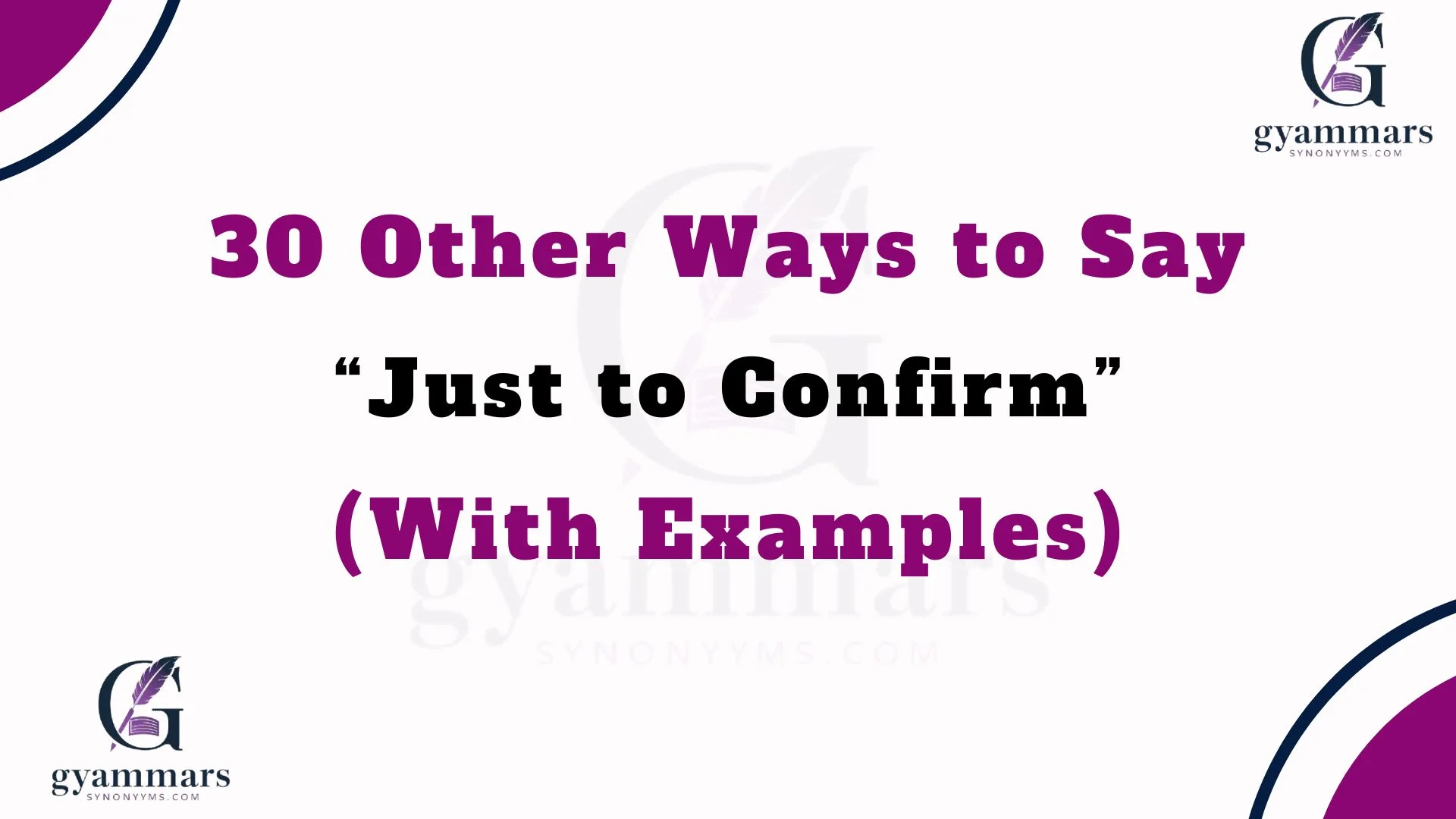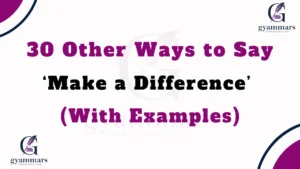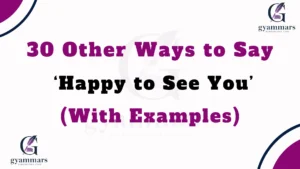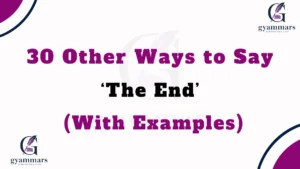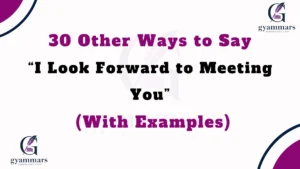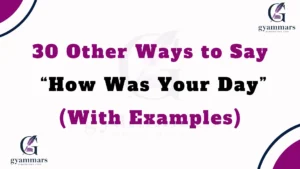Finding the right words to express yourself can make a huge difference in communication. Whether in professional emails, casual chats, or important discussions, the way you phrase a message can convey clarity, warmth, and consideration. Using alternatives to “Just to Confirm” can make your communication feel more personal, polite, and thoughtful, helping others understand your intentions clearly while maintaining a respectful tone.
What Does “Just to Confirm” Mean?
Definition: “Just to Confirm” is a phrase used to verify or clarify information before taking further action.
Detailed Explanation: It is often used to ensure everyone is on the same page, preventing miscommunication.
Scenario Examples:
- “Just to confirm, our meeting is at 3 PM tomorrow, right?”
- “I’m just confirming that you received my previous email.”
Best Use: Use this phrase when you need to double-check information politely.
Tone: Polite, professional, and neutral.
Additional Notes: Overusing it can make your messages seem repetitive, so alternative phrases are often more effective.
Is It Professional/Polite to Say “Just to Confirm”?
Definition: Yes, it is considered professional and polite, especially in business communications.
Detailed Explanation: The phrase helps clarify information without sounding pushy or demanding.
Scenario Examples:
- Emailing a colleague about a meeting time.
- Confirming deadlines with a client.
Best Use: Perfect for professional settings, particularly emails, messages, and meeting follow-ups.
Tone: Respectful, clear, and courteous.
Additional Notes: Tone may vary slightly depending on the context; alternatives can sound warmer or more casual.
Pros and Cons
Pros:
- Ensures clarity and reduces misunderstandings
- Professional and polite
- Quick and concise
Cons:
- Can feel repetitive if overused
- Slightly formal for casual conversations
- Alternatives may feel friendlier or more personable
Synonyms For “Just to Confirm”
- To Verify
- To Double-Check
- To Clarify
- To Ensure
- Just Checking
- Wanted to Confirm
- For Confirmation
- Can You Confirm
- For Your Confirmation
- Quick Confirmation
- Checking In
- Making Sure
- Just Making Sure
- To Make Sure
- As a Reminder
- For Verification
- Kindly Confirm
- Would You Mind Confirming
- Seeking Confirmation
- Confirming Details
- Can I Confirm
- Confirming With You
- To Validate
- Need Your Confirmation
- Verifying Information
- Checking Facts
- Touching Base
- Follow-Up Confirmation
- Confirming Accuracy
- Quick Check
1. To Verify
Definition: Used to ensure that information is correct.
Detailed Explanation: This phrase conveys a sense of carefulness and accuracy without sounding formal.
Scenario Examples:
- “I wanted to verify the meeting time with you.”
Best Use: Professional emails or messages when accuracy matters.
Tone: Formal, polite, professional.
Additional Notes: Suitable for work-related confirmations.
2. To Double-Check
Definition: Checking something again to ensure accuracy.
Detailed Explanation: Slightly more casual than “to verify,” friendly tone.
Scenario Examples:
- “Can we double-check the report figures before submission?”
Best Use: Internal team communications or friendly professional messages.
Tone: Friendly, careful, precise.
Additional Notes: Adds a collaborative feeling.
3. To Clarify
Definition: Making sure there is no confusion.
Detailed Explanation: Often used when instructions or information could be misunderstood.
Scenario Examples:
- “Just to clarify, are we meeting in room 502 or 503?”
Best Use: Situations where precision and understanding are key.
Tone: Neutral, polite, clear.
Additional Notes: Suitable for both professional and casual contexts.
4. To Ensure
Definition: To make certain of something.
Detailed Explanation: Expresses a proactive approach to avoid mistakes.
Scenario Examples:
- “To ensure we’re aligned, could you confirm your availability?”
Best Use: Formal communication and project coordination.
Tone: Polite, professional.
Additional Notes: Emphasizes responsibility and attention to detail.
5. Just Checking
Definition: Casual way to verify information.
Detailed Explanation: Friendly tone, informal yet polite.
Scenario Examples:
- “Just checking, did you get the email I sent yesterday?”
Best Use: Informal emails, chats, or internal team messages.
Tone: Friendly, light, approachable.
Additional Notes: Avoid in highly formal emails.
6. Wanted to Confirm
Definition: A polite way to verify information.
Detailed Explanation: Shows initiative and courtesy by phrasing it as a gentle reminder rather than a direct request.
Scenario Examples:
- “I wanted to confirm if you received the agenda for tomorrow’s meeting.”
Best Use: Emails or messages where you want to maintain a polite tone.
Tone: Warm, professional, courteous.
Additional Notes: Softens the confirmation request, ideal for sensitive communications.
7. For Confirmation
Definition: Directly requesting verification of information.
Detailed Explanation: Neutral phrase, commonly used in professional emails.
Scenario Examples:
- “Attached is the document for confirmation before submission.”
Best Use: Formal work emails or document verification.
Tone: Neutral, formal, professional.
Additional Notes: Suitable for attachments or official communications.
8. Can You Confirm
Definition: Asking someone to verify information.
Detailed Explanation: Direct and clear, often used in casual or professional settings.
Scenario Examples:
- “Can you confirm your attendance at the workshop?”
Best Use: Email requests or chat confirmations.
Tone: Direct, polite, neutral.
Additional Notes: Slightly informal depending on phrasing; “Could you please confirm” sounds more formal.
9. For Your Confirmation
Definition: A formal phrasing used to request verification.
Detailed Explanation: Often included in professional correspondence as part of polite email etiquette.
Scenario Examples:
- “Please find the attached proposal for your confirmation.”
Best Use: Formal emails and documents.
Tone: Polite, formal, professional.
Additional Notes: Common in business settings; not ideal for casual chats.
10. Quick Confirmation
Definition: Requesting a brief verification.
Detailed Explanation: Suggests that the confirmation won’t take much time, making it polite and considerate.
Scenario Examples:
- “Just need a quick confirmation that the meeting time works for you.”
Best Use: Emails or messages when time is limited.
Tone: Polite, concise, professional.
Additional Notes: Friendly, efficient; works in professional and informal contexts.
11. Checking In
Definition: Informal way of following up and confirming.
Detailed Explanation: Implies both confirmation and care, suitable for friendly professional relationships.
Scenario Examples:
- “Checking in to see if you received my previous email.”
Best Use: Casual business or team communications.
Tone: Friendly, approachable.
Additional Notes: Less formal; shows attentiveness.
12. Making Sure
Definition: Verifying information to prevent misunderstandings.
Detailed Explanation: Casual yet professional phrasing to indicate thoroughness.
Scenario Examples:
- “Just making sure the report is finalized before submission.”
Best Use: Internal team messages, informal emails.
Tone: Polite, casual, careful.
Additional Notes: Emphasizes diligence without being formal.
13. Just Making Sure
Definition: Friendly verification of information.
Detailed Explanation: Adds warmth and approachability to your message.
Scenario Examples:
- “Just making sure we’re meeting at 2 PM, not 3 PM.”
Best Use: Casual chats, internal communication.
Tone: Friendly, informal.
Additional Notes: Avoid in highly formal business emails.
14. To Make Sure
Definition: Ensuring information is correct.
Detailed Explanation: Slightly more formal than “just making sure,” versatile for both professional and casual contexts.
Scenario Examples:
- “To make sure everything is ready, can you review the document?”
Best Use: Project coordination and task verification.
Tone: Neutral, polite.
Additional Notes: Works well for reminders without sounding pushy.
15. As a Reminder
Definition: Softly confirming information while also reminding the recipient.
Detailed Explanation: Polite and thoughtful way to verify something that may have been discussed before.
Scenario Examples:
- “As a reminder, our call is scheduled for tomorrow at 10 AM.”
Best Use: Follow-up emails, meeting reminders.
Tone: Polite, professional, gentle.
Additional Notes: Helps maintain clarity without sounding commanding.
16. For Verification
Definition: Formal phrase for ensuring accuracy.
Detailed Explanation: Professional and precise, often used in official documents or emails.
Scenario Examples:
- “Attached is the data report for verification before submission.”
Best Use: Formal business communications.
Tone: Neutral, professional.
Additional Notes: Avoid casual use; suitable for official correspondence.
17. Kindly Confirm
Definition: Polite request for verification.
Detailed Explanation: Emphasizes courtesy and professionalism.
Scenario Examples:
- “Kindly confirm your attendance at the meeting.”
Best Use: Formal and semi-formal professional communication.
Tone: Polite, professional, courteous.
Additional Notes: Widely used in email etiquette.
18. Would You Mind Confirming
Definition: Very polite way to request confirmation.
Detailed Explanation: Softens the request by making it optional, yet expected.
Scenario Examples:
- “Would you mind confirming the updated schedule?”
Best Use: Polite requests, especially in sensitive professional or personal contexts.
Tone: Gentle, respectful.
Additional Notes: Shows empathy and respect for the recipient’s time.
19. Seeking Confirmation
Definition: Formal phrasing for requesting verification.
Detailed Explanation: Professional and neutral, often used in official correspondence.
Scenario Examples:
- “I am seeking confirmation on the proposed timeline.”
Best Use: Business emails, reports, and professional documents.
Tone: Formal, professional.
Additional Notes: Neutral tone suitable for upper management communications.
20. Confirming Details
Definition: Verifying specifics or important information.
Detailed Explanation: Highlights attention to detail and clarity.
Scenario Examples:
- “Confirming details of the client meeting next week.”
Best Use: Professional emails, planning, and scheduling.
Tone: Professional, attentive.
Additional Notes: Shows precision and care in communication.
21. Can I Confirm
Definition: Polite way of asking for approval or verification.
Detailed Explanation: Friendly and approachable phrasing.
Scenario Examples:
- “Can I confirm your preferred delivery time?”
Best Use: Informal or semi-formal requests.
Tone: Polite, conversational.
Additional Notes: Works well in client interactions or team settings.
22. Confirming With You
Definition: Indicates collaborative verification.
Detailed Explanation: Shows that you value the other person’s input.
Scenario Examples:
- “Confirming with you that the report is ready for submission.”
Best Use: Team emails or professional collaboration.
Tone: Professional, collaborative.
Additional Notes: Highlights teamwork and shared responsibility.
23. To Validate
Definition: Verifying the correctness or authenticity of information.
Detailed Explanation: Slightly formal, often used in technical or official contexts.
Scenario Examples:
- “We need to validate the figures before sending the report.”
Best Use: Formal documents, technical work, or data verification.
Tone: Formal, precise.
Additional Notes: Implies accuracy is critical.
24. Need Your Confirmation
Definition: Direct request for verification.
Detailed Explanation: Clearly communicates that confirmation is necessary.
Scenario Examples:
- “I need your confirmation on the proposed dates.”
Best Use: Professional settings where action depends on confirmation.
Tone: Direct, professional.
Additional Notes: Slightly more assertive, best in formal emails.
25. Verifying Information
Definition: Formal process of checking details.
Detailed Explanation: Neutral, professional, and precise.
Scenario Examples:
- “Verifying information before sending the final report.”
Best Use: Business reports, data checks, and official communications.
Tone: Professional, formal.
Additional Notes: Works well for document or report review.
26. Checking Facts
Definition: Ensuring the correctness of information.
Detailed Explanation: Slightly casual phrasing for verification purposes.
Scenario Examples:
- “Just checking facts before finalizing the presentation.”
Best Use: Team meetings, informal professional emails.
Tone: Casual, careful.
Additional Notes: Friendly tone; suitable for internal communications.
27. Touching Base
Definition: Casual phrase for checking in or confirming.
Detailed Explanation: Friendly, professional tone that emphasizes ongoing communication.
Scenario Examples:
- “Touching base to confirm the agenda for tomorrow’s meeting.”
Best Use: Internal communications and client check-ins.
Tone: Friendly, professional.
Additional Notes: Informal but respectful; conveys collaboration.
28. Follow-Up Confirmation
Definition: Ensuring verification after an initial request.
Detailed Explanation: Professional, polite way to check progress.
Scenario Examples:
- “This is a follow-up confirmation regarding the project deadlines.”
Best Use: Professional emails and project tracking.
Tone: Polite, professional.
Additional Notes: Shows responsibility and attentiveness.
29. Confirming Accuracy
Definition: Ensuring information is correct.
Detailed Explanation: Formal, precise phrase emphasizing correctness.
Scenario Examples:
- “Confirming accuracy of the financial report before submission.”
Best Use: Professional or technical verification.
Tone: Formal, precise.
Additional Notes: Best in high-stakes or technical contexts.
30. Quick Check
Definition: Friendly, concise verification of information.
Detailed Explanation: Suggests that confirmation will be brief and easy.
Scenario Examples:
- “Just a quick check—are we meeting at 4 PM?”
Best Use: Friendly emails, quick messages, or casual professional communication.
Tone: Friendly, informal.
Additional Notes: Good for fast confirmations without sounding demanding.
Conclusion
Choosing the right phrase instead of “Just to Confirm” can make your communication more polished, thoughtful, and effective. Some alternatives are formal and professional, while others are friendly and casual, giving you flexibility depending on the situation. By selecting a phrase that fits the context, you can convey clarity, warmth, and respect, ensuring your messages are well-received and understood.
FAQs
Q1. What does “Just to Confirm” mean in communication?
“Just to Confirm” is used to double-check details, clarify understanding, or ensure that both parties are aligned on information.
Q2. Is it professional to use alternatives to “Just to Confirm”?
Yes, using polite and varied alternatives can make communication sound more thoughtful and professional in emails, meetings, or messages.
Q3. When should I use “Just to Confirm” or its alternatives?
You can use them when verifying details such as meeting times, agreements, instructions, or any information that requires accuracy.
Q4. What are some casual alternatives to “Just to Confirm”?
Casual options include phrases like “Just making sure,” “Wanted to check,” or “So we’re on the same page.”
Q5. Can I use “Just to Confirm” in both spoken and written communication?
Absolutely. It works well in emails, chats, and conversations, but choosing alternatives can make your tone warmer and more engaging.

“Mia Rose at Grammar Synonyms is your ultimate guide to mastering language with style and precision. Whether you’re looking to enhance your vocabulary, perfect your grammar, or discover the ideal synonym, Mia Rose offers expert resources and creative solutions to help you express yourself flawlessly. With Grammar Synonyms, unlock a world of language possibilities and elevate every piece of writing you create.
